User:SwitchTilt/sandbox
 | This is a user sandbox of SwitchTilt. You can use it for testing or practicing edits. This is not the sandbox where you should draft your assigned article for a dashboard.wikiedu.org course. To find the right sandbox for your assignment, visit your Dashboard course page and follow the Sandbox Draft link for your assigned article in the My Articles section. |
Corset Controversy[edit]
This article contains too many or overly lengthy quotations. (March 2013) |

The corset controversy concerns supporters' and detractors' arguments for and against wearing a corset. The controversy was contemporary with the time that corsets were popular in society. Corsets, variously called a pair of bodys or stays, were worn by European women from the late 16th century onward, changing their form as fashions changed. In spite of radical change to fashion geographically and temporally, the corset or some derivative beneath an outer gown would shape the body or provide structure.
There were brief periods in which corsetry was not part of mainstream fashion. In the 1790s, there was an abrupt change to fashion as the Empire silhouette became fashionable. During the following Regency era the highly supportive corsets of the early Georgian era were dismissed in favour of short garments worn primarily to support the breast and leave the waist and hips in their natural shape.[1]


Beginning in the mid-1820s, women's fashion returned to the full skirts of the prior century. In a repudiation of the Empire silhouette, the waist became the central focus of female dress. The corset assumed the dominant role it would hold for the rest of the 19th century. Designed to emphasize the waist through minimising it, corsets would constrict the waistline in order to achieve a slender silhouette.[2] Doctors and much of the press deplored the garment in spite of continued use.[3]
Criticism[edit]
Wearing corsets has been subject to criticism since the era of tight lacing during the prior century. Jean-Jacques Rousseau denounced the practice in The Lancet[4] while cartoons of the period satirized the practice. However, by the 19th century, women were writing letters to publications expressing their views directly and articulately. The one-sided denunciation of the past turned into a dialogue. Women made their voices heard, sharing their experiences and their opinions, some in favor of the corset and even tight lacing, and some in disfavor of the restrictive garment. Newspapers and popular journals became the media for the exchange of hundreds of letters and articles concerning the corset.
Known as the "corset controversy" or simply the "corset question", the controversy spilled over multiple publications, multiple decades, and multiple countries. Of particular concern was the issue of tight lacing. The flow of articles and letters waxed and waned over time, reaching a crescendo in the late 1860s, which may be taken to be the peak of the frenzy[citation needed]. However, the issue surfaced long before and continued long afterward. Throughout this period, advertisements in the same publications promoted the sale of corsets with enthusiasm.[5]

In the United Kingdom, publications in which the controversy raged included The Times, Lancet, Queen, The Scotsman, Ladies Treasury, The Englishwomen's Domestic Magazine, and All the Year Round. In the United States, the Chicago Tribune commented that English journalists discussed both sides of the controversy "with very great fervor and very little common sense," though it published its own contributions.[6] Other American newspapers and periodicals also participated, including The New York Times, The Washington Post, The Boston Globe, the Hartford Daily Courant, the North American Review, and The Saint Paul Daily Globe. Other parts of the English-speaking world joined from time to time, reprinting articles from England and America, as well as contributing their own. Even provincial newspapers such as the Amador Ledger of California, the Hobart Town Courier, the Otago Witness, and the Timaru Herald of New Zealand had their say.

The line between wearing corsets in general and tight lacing in particular was never drawn precisely. Many detractors denounced both, obviating the distinction, while many advocates endorsed both. Additionally, many women who wore corsets denied that they tight laced, adding confusion to the controversy. The West Coast Times wrote that "consequences of tight lacing are universally admitted," yet ladies' denial persisted . They preferred to claim that their small waist was "a gift of Nature" and that they wear a corset for "comfortable, if not necessary support." [7]
Medical criticism arose, as doctors declared the practice decidedly harmful and railed against it. Some women replied that tight lacing was actually beneficial as well as enjoyable, while other women responded to the critiques with wholehearted agreement, sometimes citing their own negative experiences. The distinguished anatomist William Henry Flower in 1881 published a book [8] demonstrating by text and illustrations the deformities caused to female anatomy by corsets.[9][10] However, this did not prevent even his wife and four daughters from wearing them.
Corsets and fashion[edit]

The dominant aesthetic of the mid-nineteenth century called for full skirts. Prior to the common wearing of the crinoline, several petticoats would be worn in order to provide this fullness. A corset, used to constrict the waist and create slenderness, could also accentuate a full skirt through comparison. There were countless denunciations. Fashions that required a tiny waist were deemed oppressive. One such appeared in the Chicago Tribune claiming that "[i]t is difficult to imagine a slavery more senseless, cruel or far-reaching in its injurious consequences than that imposed by fashion on civilized womanhood during the last generation." [11] Yet some women professed to enjoy the practice. A reader wrote to The Toronto Daily Mail insisting that only those who had experienced tight lacing could understand its pleasures.[12] Newspapers often received letters from women adocating tight lacing and providing recommendations to get the best effect.

Mothers and daughters[edit]
It was expected that women would wear corsets and it was part of a mother's duty to her female offspring to have them wear the garment.[13] Just how and when might depend on the mother, the daughter, the place, and the time.
In some cases, mothers started their daughters wearing corsets in early childhood.[14] Mothers typically put their daughters into serious corsets in their teens or sometimes in the pre-teens. Some were uncertain as to when and how to begin tight lacing. They sought advice in their local newspapers, giving rise to heated discussions.
Girls would seek relief from their stays at night and mothers would seek to prevent it.[21] Some objected entirely to corsets until the very end of the teenage years.[21]
School[edit]
In fashionable society, a girl was expected to have a suitably small waist. Girls' schools were preparation for society and some headmistresses treated that attainment as part of the girls' schooling. As the girl was not yet an adult, her opinion was not considered. A reader wrote to the editors of The Science of Health to describe her experience attending a fashionable boarding school which incorporated a focus on figure-training.[15]
The reliance on corsets in daily life also caused an “unwholesome appetite” for tight lacing.[15] Mothers may request specific waist sizes to teachers who work to make these measurements possible before the girls leave school.
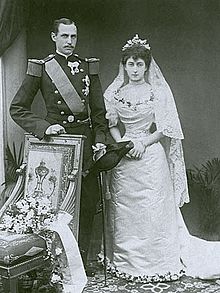

Marriage[edit]
There are many articles admonishing girls to abjure the custom of tight lacing, assuring them that no man they would want to marry had any interest in small waists. One idea behind this is that men “shudder” at the thought of an unnaturally tiny waist which is “inconsistent with true beauty.”[16]
Another viewpoint is that men “dread the thought of marrying a woman who is subject to fits of irritable temper, to headaches and other ailments we need not mention, all of which, everybody knows, are the direct and inevitable product of the compression of the waist”. [17]
In contrast, some articles suggest that marriage caused tight lacing to increase. This was attributed to preparation for the wedding[18]or sometimes due to husbands’ preference for them to have a smaller waist.[19]
Fashion establishments[edit]
Girls working in "fashion establishments", as they were then called, wore corsets to suit the dictates of their employers. Tiny waists were required of employees to sell the then current fashions, much as size zero models are frequently used in fashion shows today.[20]
To make help get this figure, fashion establishments utilized locked corsets, as described below[21]:
- Now there is one practice which is painfully common among all classes, and that is the use of the "locked corset". This is practically a steel corset, with a waist varying from about 14in to 16in. Into this the growing girl is compressed by force, the corset is shut tight and secured by a lock, the key being kept by the mother or whoever is responsible for the proceeding.
- It may be observed here that it is the usual practice for the heads of "trying on" departments in large dress-making and mantle-making establishments to require all girls engaged in "trying on" to enter one of these corsets, which is locked, and the key kept by the head. In the case of the growing girl, the object is to prevent the waist from growing as the rest of the body develops...
The dress reform movement[edit]
Advocates of dress reform deplored the impractical and restrictive fashions of the time. The bloomer dress was a mid-century attempt at rational clothing for women. It attracted considerable ridicule in the press and relatively few adopters. Other attempts at dress reform fared no better.
Various dress reformers turned to the printing press. In 1873, Elizabeth Stuart Phelps Ward wrote:[22]
Burn up the corsets! ... No, nor do you save the whalebones, you will never need whalebones again. Make a bonfire of the cruel steels that have lorded it over your thorax and abdomens for so many years and heave a sigh of relief, for your emancipation I assure you, from this moment has begun.
Louisa May Alcott devoted Chapter 18 ("Fashion and Physiology") of her 1875 young adult fiction, Eight Cousins, to advocating for dress reform in the form of the "freedom suit," which is described as being different from and more socially acceptable than bloomers. The young main character, Rose Campbell, is under the guardianship of her physician uncle Alec. However, her aunt Clara wishes Rose to dress appropriately to her position as an heiress, and one day gives her a fashionable outfit to try. Rose ultimately rejects it in favor of Alec's freedom suit, consisting of close-fitting pantaloons and shirt under a long-skirted petticoat and dress. Earlier in the novel, Rose had been wearing a tight belt to keep her waist small, which Alec insisted she stop doing for the sake of her health (Chapter 5, "A Belt and a Box"). When Clara tries to convince her to wear a corset, Alec is furious because he would rather her be healthy in her natural shape.
The dress reform had little mainstream impact. Fashion continued to emphasize the waist and, so long as it did, the corset continued to be regarded as an indispensable of dress.
End of the controversy[edit]

From 1908 to 1914, the fashionable narrow-hipped and narrow-skirted silhouette necessitated the lengthening of the corset at its lower edge. A new type of corset covered the thighs and changed the position of the hip, making the waist appear higher and wider.[23] The new fashion was considered uncomfortable, cumbersome, and furthermore required the use of strips of elastic fabric. The development of rubberized elastic materials in 1911 helped the girdle replace the corset. This was the huge turnaround for the history of waist trainer.
The corset controversy changed in the early 20th century when the world of fashion circled back to styles reminiscent of the Empire silhouette. Fashionable dress was fluid and soft, with flowing lines. What rational dress reform was unable to accomplish in decades of rhetoric, the wheel of changing fashion brought about almost overnight. The waist became unimportant and the waist-restricting corset lost its significance.
Paul Poiret was a leader in this movement. He replaced the corset with the hobble skirt,[24] which, while equally restrictive, was different and thus readily adopted in an era eager for change.[25] In his autobiography, Poiret wrote[26]
- It was in the name of Liberty that I proclaimed the fall of the corset and the adoption of the brassiere, which since then, has won the day. Yes, I freed the bust, but I shackled the legs.
The hobble skirt lasted but a few years, but its adoption marked the beginning of the end. Other designers such as Madeleine Vionnet, Mariano Fortuny, and Coco Chanel soon followed with simple comfortable fashions that freed the entire woman. With their adoption into mainstream fashion, the corset controversy receded into a historical curiosity.[27]
See also[edit]
Quotes from Corset Controversy
Notes[edit]
- ^ Jenkins, David (ed.), The Cambridge History of Western Textiles, Cambridge University Press, September 2003, p. 903
- ^ Ewing, Elizabeth, Dress and Undress, A History of Women's Underwear, London 1978
- ^ The Lancet, Volume 94, Issue 2400, 28 August 1869, "The Waist of the Period"
- ^ Rousseau, Jean Jacques. "On Tight Lacing" The Lancet, 9, 1785, pp. 1202–3
- ^ Wikimedia Commons, Category: Corset advertisements
- ^ "The Corset Question". Chicago Tribune (14 November 1869)
- ^ "The Pinch of Fashion", West Coast Times, (4 August 1884) p. 3
- ^ Fashion In Deformity As Illustrated In The Customs Of Barbarous & Civilised Races By William Henry Flower, Ll.D. F.R.S. F.R.C.S. P.Z.S. Hunterian Professor Of Comparative Anatomy And Conservator Of The Museum Of The Royal College Of Surgeons Of England. London, Macmillan And Co. 1881. Available at https://archive.org/details/fashionindeform00flowgoog
- ^ en.wikisource.org/wiki/Flower,_William_Henry_(DNB01)
- ^ https://en.wikisource.org/wiki/1911_Encyclop%C3%A6dia_Britannica/Flower,_Sir_William_Henry
- ^ "The Slaves of Fashion" Chicago Tribune (5 September 1891)
- ^ "The Proof of the Pudding" Toronto Daily Mail (5 May 1883) p. 5
- ^ Summers, Leigh, Bound to Please: A History of the Victorian Corset, Berg, 2003, chapter 3
- ^ "The Fashions for Summer" New York Times", (26 June 1881)
- ^ a b "Voices of the People" The Science of Health, Vol. III – July to December 1873. p. 245
- ^ "Deviations from Nature" Hobart Town Courier (10 February 1837)
- ^ "Tight Lacing" Hartford Daily Courant (1 November 1884)
- ^ "The Health of the American Woman" North American Review (1 December 1882)
- ^ "Foolish Fashions" All the Year Round (27 June 1868)
- ^ "London Fashion Week refuses to ban 'size 0' models from catwalk" The Independent (26 January 2007)
- ^ "Ladies' Gossip" Otago Witness (2 May 1895) p. 46
- ^ Phelps, Elizabeth (1873). What to Wear. Boston: Osgood. p. 79.
- ^ Shah, Veronica. "Omorfio : DIY Beauty Tips and Style Trends". omorfio.com. Retrieved 16 December 2016.
- ^ "Waistless Gowns Are Again Exploited by Poiret" New York Times (15 October 1911)
- ^ Ewing, Elizabeth, Dress and Undress, A History of Women's Underwear, London 1978, p.113
- ^ Poiret, Paul, My first fifty years, Gollancz, 1931, p. 73
- ^ "Waist cincher". waistcincher.org. Retrieved 23 August 2015.
{{DEFAULTSORT:Corset Controversy}} [[:Category:19th-century fashion]] [[:Category:Corsetry]] [[:Category:Fashion]] [[:Category:Foundation garments]] [[:Category:History of clothing (Western fashion)]]
Crepe[edit]
This article has multiple issues. Please help improve it or discuss these issues on the talk page. (Learn how and when to remove these template messages)
|
 A stack of crêpes | |
| Alternative names | Crepe |
|---|---|
| Type | Pancake |
| Place of origin | France |
| Serving temperature | Warm or Hot |
| Main ingredients | Wheat flour or buckwheat flour, milk, eggs |
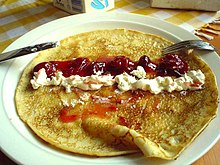
A crêpe or crepe (/kreɪp/ ⓘ[1] or /krɛp/, French: [kʁɛp] ⓘ, Quebec French: [kʁaɪ̯p] ⓘ) is a type of very thin pastry. Crêpes are usually of two types: sweet crêpes (crêpes sucrées) and savoury galettes (crêpes salées). Crêpes are served with a variety of fillings, from the simplest with only sugar to flambéed crêpes Suzette or elaborate savoury galettes. While crêpes are often associated with Brittany, a region in the northwest of France, their consumption is widespread in France, Belgium, Canada, and many parts of Europe, North Africa, and the Southern Cone of South America.
Etymology[edit]
Crêpes belong to the general category of ancient Greek Tiganitai, from Greek tiganos (τίγανος), meaning "frying pan", which in English is literally translated to Pancakes [2]. The French term, crêpe, derives from the Latin crispa, meaning tiganitai with "creases". The name "galette" came from the French word galet ("pebble") since the first gallettes were made on a large pebble heated in a fire.
Traditions[edit]
In France, crêpes are traditionally served on Candlemas (La Chandeleur), 2 February. This day was originally Virgin Mary's Blessing Day but became known in France as "Le Jour des Crêpes" (literally translated "The Day of the Crêpes", and sometimes called colloquially as "Avec Crêpe Day", "National Crêpe Day", or "day of the Crêpe "), referring to the tradition of offering crêpes. The belief was that catching the crêpe with a frying pan after tossing it in the air with your right hand while holding a gold coin in your left hand would cause you to become rich that year.[3][4] The roundness, and golden color from being fried in butter, of the crêpe resembles the sun and its rays. This symbolism also applies to the coin held in the person's hand.[5]
Types of crêpes[edit]
Sweet crêpes are generally made with wheat flour (farine de froment). When sweet, they can be eaten as part of breakfast or as a dessert. Common fillings include Nutella spread, preserves, sugar (granulated or powdered), maple syrup, golden syrup, lemon juice, whipped cream, fruit spreads, custard, and sliced soft fruits or confiture.
Savory crêpes are made with non-wheat flours such as buckwheat. Batter made from buckwheat flour is gluten-free, which makes it possible for people who have a gluten allergy or intolerance to eat this type of crêpe. Common savoury fillings for crêpes served for lunch or dinner are cheese, ham, and eggs, ratatouille, mushrooms, artichoke (in certain regions), and various meat products.
Batters can also consist of other simple ingredients such as butter, milk, water, eggs, flour, salt, and sugar.[6] Fillings are commonly added to the center of the crêpe and served with the edges partially folded over the center.
Crêperies[edit]
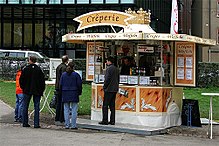

A crêperie may be a takeaway restaurant or stall, serving crêpes as a form of fast food or street food, or may be a more formal sit-down restaurant or café.[7]
Crêperies are typical of Brittany in France; however, crêperies can be found throughout France and in many other countries.
Because a crêpe may be served as both a main meal or a dessert, crêperies may be quite diverse in their selection and may offer other baked goods such as baguettes. They may also serve coffee, tea, buttermilk, and cider (a popular drink to accompany crêpes).[8]
Special crêpes[edit]
This section needs additional citations for verification. (February 2015) |

Mille crêpes is a French cake made of many crêpe layers. The word mille means "a thousand", implying the many layers of crêpe.[9] Another standard French and Belgian crêpe is the crêpe Suzette, a crêpe with lightly grated orange peel and liqueur (usually Grand Marnier) which is subsequently lit upon presentation.[10]
English pancakes are like wheat flour crêpes, and are served with golden syrup or lemon juice and sugar. Swedish pancakes, also called Nordic pancakes, are similar to the French crêpes. In some of the Nordic countries, they are served with jam or fruit, especially lingonberries (or the butter from that fruit) as a dessert with a variety of savory fillings. Traditional Swedish variations can be exotic. Beside the usual thin pancakes, called pannkakor in Swedish and räiskäle in Finnish, which resemble the French crêpes and, often served with whipped cream and jam, are traditionally eaten for lunch on Thursdays with pea soup, the Swedish cuisine (as well as the Finnish one) has plättar/lettu which resemble tiny English pancakes, and are fried several at a time in a special pan. Others resemble German pancakes but include fried pork in the batter (fläskpannkaka); these are baked in the oven. Potato pancakes called raggmunk contain shredded raw potato and may contain other vegetables (sometimes the pancake batter is omitted, producing rårakor). Raggmunk and rårakor are traditionally eaten with pork rinds and lingonberry jam. A special Swedish pancake is saffron pancake from Gotland, made with saffron and rice, baked in the oven. It is common to add lemon juice to the sugar for extra taste. The pancakes are often served after a soup. Another special "Swedish pancake" is the äggakaka (eggcake), also called skånsk äggakaka (scanian eggcake), it is almost like an ordinary Swedish pancake but it is a lot thicker and also a lot more difficult to make due to the risk of burning it. It is made in a frying pan and is about 1½ to 2 inches thick and is served with lingonberries and bacon. The Norwegian variety is commonly eaten for dinner, traditionally with bacon, jam (typically bilberry jam) or sugar.
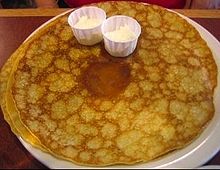
The 49er flapjack is a sourdough crepe which is popular in the United States,[11] getting its name from the popularity of this style of pancake during the California Gold Rush. Because it is similar to a Swedish pancake the 49er is sometimes served with lingonberry sauce, although most often it is rolled up with butter and powdered sugar, or served open-faced and topped with maple syrup.
Cherry Kijafa Crêpes are also often common and are made with a traditional crêpe base, but filled with cherries simmered in a Kijafa wine sauce.[12]
Crêpe dentelle is a crispy biscuit made with a very thin layer of crêpe folded in a cigar shape and then baked. It is usually enjoyed with a hot drink during the goûter, in France.[13]
In other countries[edit]


In Norwegian, crêpes are called Pannekake, in most German regions Pfannkuchen. In Swedish, a crêpe is called pannkaka in southern regions while being called "plättar" in the north, in Danish, pandekager ("pancake"), in Icelandic it is called "Pönnukaka",in Finnish a crêpe is called either ohukainen or lettu or räiskäle, in Dutch it is a pannenkoek or flensje, and in Afrikaans a pannekoek, which is usually served with cinnamon sugar. In the Spanish regions of Galicia and Asturias, they are traditionally served at carnivals. In Galicia, they're called filloas, and may also be made with pork blood instead of milk. In Asturias, they are called fayueles or frixuelos, and in Turkey, "Akıtma".
In areas of central Europe, formerly belonging to the Austro-Hungarian empire, there is a thin pancake comparable to a crêpe that in Austro-Bavarian is called Palatschinken; in Hungarian: palacsinta; and in Bosnian, Serbian, Bulgarian, Macedonian, Montenegrin, Czech, Croatian, and Slovene: palačinka; in Slovak: palacinka. In the Balkan region such as the countries of Albania, Bosnia, Croatia, Kosovo, Macedonia, Montenegro, and Serbia, palačinka or pallaçinka may be eaten with fruit jam, quark cheese, sugar, honey, or the hazelnut-chocolate cream Nutella, while there is also a breaded variant which is mostly filled with meat. Restaurants which are specialized in palačinci are called "Palačinkara" in the region. In Ashkenazi Jewish cuisine, there is a similar dish known as the blintz. The Oxford English Dictionary derives the German and Slavic words from the Hungarians palacsinta, which it derives from the Romanian plăcintă, which comes in turn from classical Latin placenta ("small flat cake"), even though the Romanian plăcintă is more similar to a pie, and the crêpes are actually called clătită.
Crêpes have also long been popular in Japan, with sweet and savoury varieties being sold at many small stands, usually called crêperies. In Argentina and Uruguay, they are called panqueques and are often eaten with dulce de leche. Various other French foods, such as crêpes, souffles, and quiche, have slowly made their way into North American cooking establishments.[14] Typically, these franchises stick to the traditional French method of making crêpes but they have also put their own spin on the crêpe with new types such as the hamburger and pizza crêpe. In Mexico, crêpes are known as crepas, and were introduced during the 19th century by the French [15][16] and are typically served either as a sweet dessert when filled with cajeta (similar to dulce de leche), or as a savoury dish when filled with Huitlacoche (corn smut), which is considered a delicacy.
Crêpes in European culture[edit]
During Russian celebration of Maslenitsa (Russian Butter Week), one of the most popular foods is blini, or crepes. Since crepes are made from butter, eggs and milk, they are allowed to be consumed during the celebration by the Orthodox church. There are endless combinations to the recipes and the execution of crepes. White flour can be replaced with buckwheat flour and milk can be switched for kefir. Also different oils can be added or substituted. Blini are served stocked with a piece of butter and topped with caviar, cheese, meat, potatoes, mushrooms, honey, berry jam or often a dollop of sour cream. The dish is supposed to represent the sun, since the holiday is about the beginning of the spring. [17]
In addition to crêperies and crêpe franchises, there are crêpe manufacturers that use modern equipment to produce crêpes in bulk.
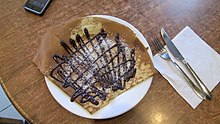
Dishes with similar appearance, taste and preparation methods exist in other parts of the world as well. In South India, a crêpe made of fermented rice batter is called a dosa, which often has savoury fillings. In Western India, a crepe made of gram flour is called Pudlaa/Poodla, with the batter consisting of vegetables and spices. Another variety is called patibola and is sweet in taste due to milk, jaggery or sugar. The injera of Ethiopian/Eritrean/Somali/Yemeni cuisine is often described as a thick crêpe. Also in Somalia, Malawaḥ (Somali: Malawax) is very similar to a crêpe. It is mostly eaten at breakfast.
The names for thin crêpes in other parts of Europe are:
- Albanian: pallaçinka
- Asturian: frixuelo
- Bosnian: palačinka
- Breton: krampouezh
- Bulgarian: палачинка
- Cornish: krampoeth
- Croatian: palačinka
- Czech: palačinka
- Estonian: pannkook, ülepannikook
- Faroese: pannukaka
- Finnish: ohukainen, lätty, lettu or räiskäle
- Galician: filloas
- German: Palatschinke
- Greek: κρέπα (krépa)
- Hungarian: palacsinta
- Icelandic: pönnukaka
- Italian: crespella
- Kazakh: құймақ (quymaq)
- Latvian: pankūka
- Lithuanian: lietiniai blynai
- Macedonian: палачинка
- Polish: naleśniki
- Portuguese: crepe
- Romanian: clătită
- Russian: блины (bliny)
- Serbian: палачинка
- Slovak: palacinka
- Slovene: palačinka
- Spanish: crepes
- Turkish: krep, akıtma
- Ukrainian: млинці, налисники (mlyntsi, nalysnyky)
- Welsh: cramwyth
See also[edit]
- Bánh xèo
- Blintz
- Crêpe bretonne
- Crepe maker, crepe cooking device
- Dosa
- Galette, another kind of Breton pancake, also from Brittany, France
- Injera
- Jianbing, a traditional Chinese street food similar to crepe
- Kouign amann, another Breton delicacy
- Krampouz, crepe maker manufacturer, also from Brittany, France
- List of brunch foods
- List of pancakes
- Maslenitsa
- Memiljeon
- Palatschinken
- Pancake Day
- Popiah, Chinese roll wrapped in a thin crepe made by "wiping" dough on a hot plate
- Ploye, a buckwheat pancake originating from Acadian cuisine of Canada
- Poffertjes, small ball-shaped pancake, particularly popular in the Netherlands
- Roti prata
- Sope
- Swedish pancake
- Tava
References[edit]
- ^ Longman Pronunciation Dictionary. 3rd Ed. 2008.
Merriam-Webster Dictionary - ^ [Athenaeus, Deipnosophistae, XIV, 645c; Galen, On the Properties of Foods, I, 3]
- ^ Clay, Xanthe (17 February 2007). "With a flame in your art". The Daily Telegraph. London. Retrieved 25 April 2008.
- ^ Redmond, Barbara (30 January 2012). La Chandeleur – Le Jour des Crêpes. Retrieved on 28 February 2012 from http://awomansparis.wordpress.com/2012/01/30/la-chandeleur-le-jour-des-crepes/.
- ^ Sokolov, Raymond. "Sun food." Natural History May 1993: 82. Academic Search Complete.
- ^ "Wrap it up in a crêpe; Thin pancakes work in savoury or sweet dishes." Times Colonist (Victoria, British Columbia). (24 April 2013 Wednesday) LexisNexis Academic.
- ^ "La Creperie Cafe". Retrieved 3 December 2012.
- ^ "La Creperie Key West". Archived from the original on 5 November 2012. Retrieved 3 December 2012.
- ^ Hesser, Amanda (15 May 2005). "The Way We Eat: Building a Modern, Multistoried Dessert". The New York Times.
- ^ Courtine, Robert J. (1984), Larousse gastronomique (French edition), Paris: Librairie Larousse.
- ^ http://articles.latimes.com/1995-03-16/news/ol-43368_1_original-pancake-house
- ^ Pancake House (2007). "Cherry Kijafa Crepes"; retrieved from http://www.originalpancakehouse.com/phm_crepes2.html.
- ^ "lace crepes". Retrieved 4 December 2012.
- ^ Benenson, R. (1984). Dining in America. Editorial research reports 1984 (Vol. I). Washington, DC: CQ Press.
- ^ Fernández-del-Villar, Miguel Angel and Ruiz-Naufal, Víctor M., Mesa Mexicana (1993), Fundación Cultural Bancomer, ISBN 9789686084948
- ^ http://www.mexconnect.com/articles/2139-the-french-influence-on-mexican-cooking-la-comida-afrancescada
- ^ http://eurokulture.missouri.edu/buttery-crepes-of-deliciousness-and-other-stuff/
- 19. Life A La Henri – Being The Memories of Henri Charpentier, by Henri Charpentier and Boyden Sparkes, The Modern Library, New York, 2001 Paperback Edition. Originally published in 1934 by Simon & Schuster, Inc.
External links[edit]
 Media related to Crêpe at Wikimedia Commons
Media related to Crêpe at Wikimedia Commons The dictionary definition of switchtilt/sandbox at Wiktionary
The dictionary definition of switchtilt/sandbox at Wiktionary SwitchTilt/sandbox at the Wikibooks Cookbook subproject
SwitchTilt/sandbox at the Wikibooks Cookbook subproject
[[:Category:Pancakes]]
[[:Category:Belgian cuisine]]
[[:Category:Breton cuisine]]
[[:Category:Desserts]]
[[:Category:European cuisine]]
[[:Category:French cuisine]]
[[:Category:French desserts]]
[[:Category:Snack foods]]
[[:Category:Street food]]
[[:Category:Articles containing video clips]]
[[:Category:National dishes]]

